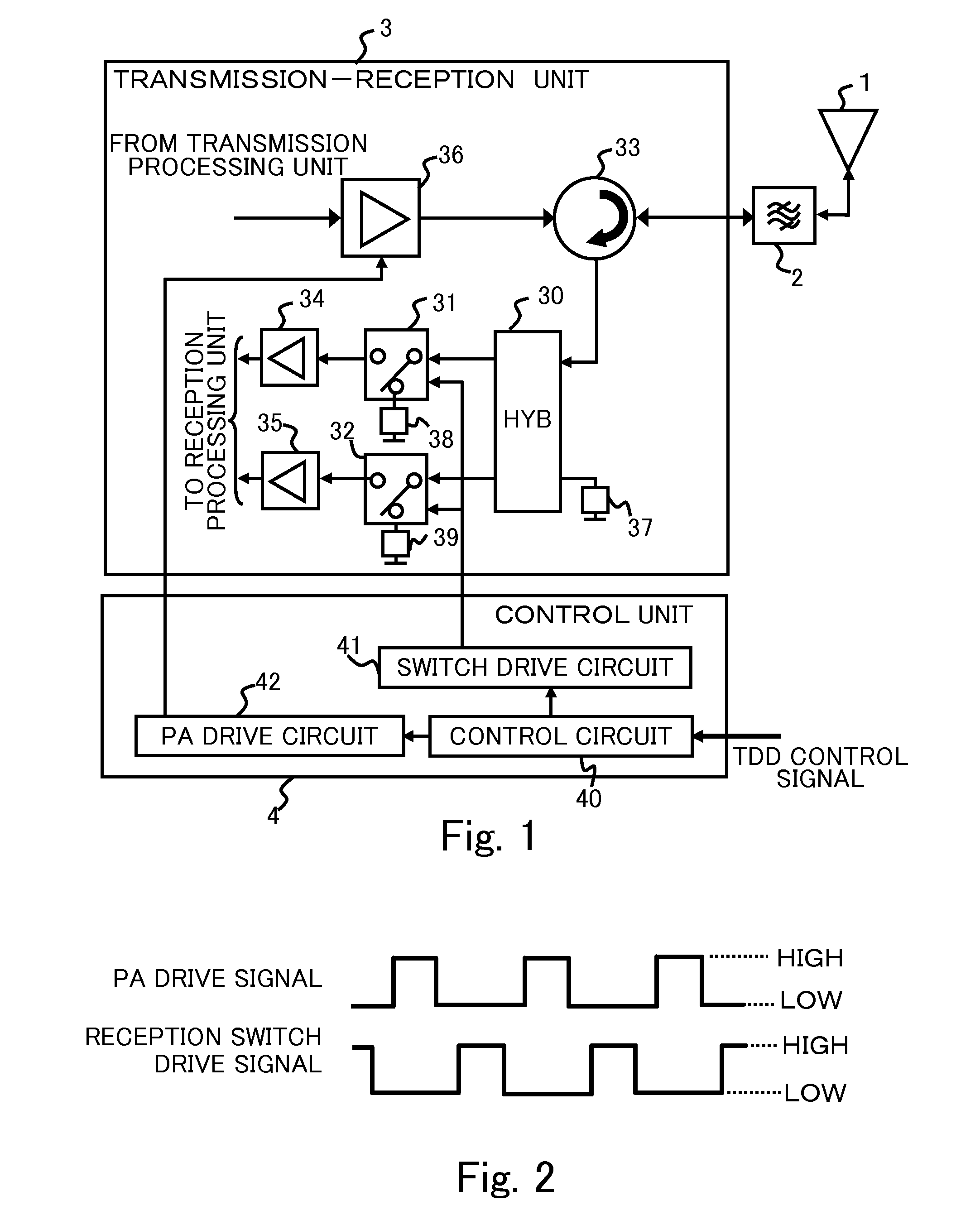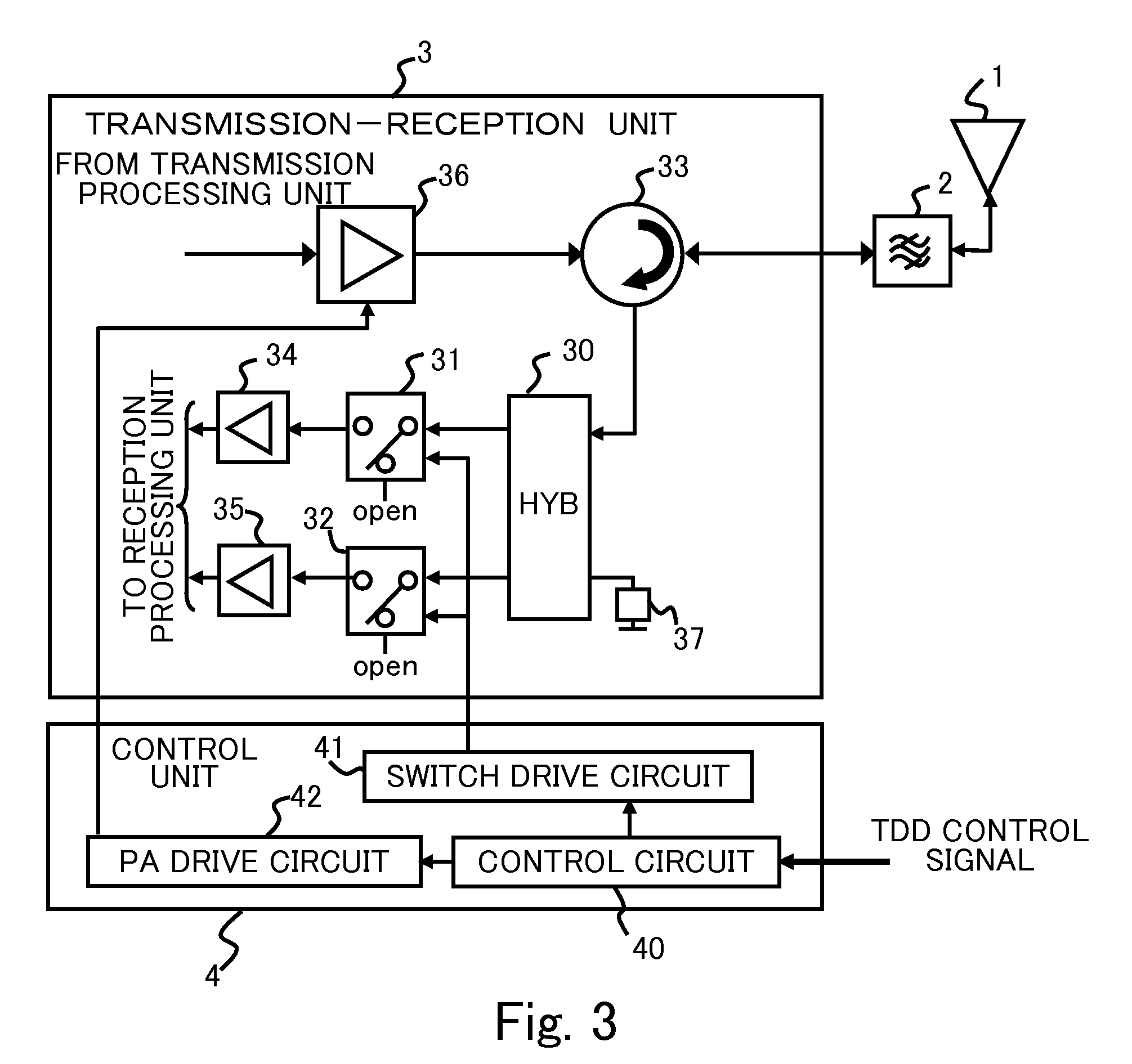Transmitter-receiver
a technology of transmitter and receiver, applied in the direction of electrical equipment, digital transmission, radio transmission, etc., can solve the problems of power amplifier on the transmission side, inability to operate the transmission amplifier in a satisfactory state, and increased cos
- Summary
- Abstract
- Description
- Claims
- Application Information
AI Technical Summary
Benefits of technology
Problems solved by technology
Method used
Image
Examples
first embodiment
[0026]As shown in FIG. 1, in the transmission-reception unit 3, the transmitter-receiver includes the first directional coupler 30, the first SPDT switch 31, the second SPDT switch 32, a circulator 33 having a function as a transmission / reception switching circuit, a first low noise amplifier 34 having a function as a first reception amplifier, a second low noise amplifier 35 having a function as a second reception amplifier, an large power amplifier 36 having a function as a transmission amplifier. The circulator 33 includes a port for antenna, a port for reception, and a port for transmission.
[0027]The port for antenna is connected to the antenna 1, or connected to the band pass filter 2 when the band pass filter 2 is provided between the transmission-reception unit 3 and the antenna 1. The port for reception is connected to the first port of the first directional coupler 30. The port for transmission is connected to an output terminal of the large power amplifier 36. An input ter...
second embodiment
[0045]FIG. 3 is a block diagram showing a construction of a transmitter receiver apparatus according to a second embodiment. As shown in FIG. 3, in the transmitter-receiver, the second output terminal of the first SPDT switch 31 is in an opened state, and the fourth output terminal of the second SPDT switch 32 is in an opened state. The rests of the construction and the operations is the same as those of the first embodiment. In this way, even though the second output terminal of the first SPDT switch 31, and the fourth output terminal of the second SPDT switch 32 are not connected to the terminator of 50Ω, reflecting waves from the first SPDT switch 31 or the second SPDT switch 32 are cancelled in the first directional coupler 30 during transmission, the load as viewed from the transmission side is always 50Ω.
third embodiment
[0046]FIG. 4 is a block diagram showing a construction of a transmitter receiver apparatus according to a third embodiment. As shown in FIG. 4, the transmitter-receiver includes a second directional coupler 50, an in-phase combining circuit 51, and a VSWR detection circuit 52, and is operable to detect a voltage standing wave ratio (VSWR), using the output power of the large power amplifier 36 as forward power. The second directional coupler 50 is connected to the output terminal of the large power amplifier 36. The second directional coupler 50 is constituted, for example, by a coupler connected to the terminator 53 of 500Ω, and is operable to take out a part of a transmission signal outputted from the large power amplifier 36.
[0047]The in-phase combining circuit 51 is connected to the second output terminal of the first SPDT switch 31 and the fourth output terminal of the second SPDT switch 32. The in-phase combining circuit 51 combines two signals inputted from the first SPDT swi...
PUM
 Login to View More
Login to View More Abstract
Description
Claims
Application Information
 Login to View More
Login to View More - R&D
- Intellectual Property
- Life Sciences
- Materials
- Tech Scout
- Unparalleled Data Quality
- Higher Quality Content
- 60% Fewer Hallucinations
Browse by: Latest US Patents, China's latest patents, Technical Efficacy Thesaurus, Application Domain, Technology Topic, Popular Technical Reports.
© 2025 PatSnap. All rights reserved.Legal|Privacy policy|Modern Slavery Act Transparency Statement|Sitemap|About US| Contact US: help@patsnap.com



